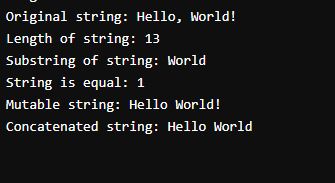Strings are a fundamental concept in programming, and they are used to represent text in many different applications. In Objective-C, a string is an object that represents a sequence of characters. A string can be created using several built-in classes and methods, which allow you to manipulate the text and perform various operations. A string is a sequence of characters, such as letters, digits, and symbols. In Objective-C, a string is an object that represents this sequence of characters. A string can be created using a class, which is a blueprint for creating objects. Once you have created a string object, you can use various methods to manipulate the text and perform operations on it. Objective-C provides several types of strings that can be used to create and manipulate text.
Types of Strings
- NSString: It is an immutable object that represents a sequence of characters. Once created, it cannot be changed. NSString is the most commonly used type of string in Objective-C.
- NSMutableString: It is a mutable object that represents a sequence of characters. It can be modified after creation, and new characters can be added or removed.
- CFString: It is a Core Foundation object that represents a sequence of Unicode characters.
Built-in Methods for Strings
Objective-C provides several built-in classes and methods for creating and manipulating strings. Some of the most commonly used methods are:
Methods
| Purpose
|
|---|
| NSString | It is an immutable class used to create a string that cannot be changed once created. |
| NSMutableString | It is a mutable class used to create a string that can be changed after it is created. |
| length | It is a method used to get the length of the string. |
| stringWithFormat | It is used to format a string with values. |
| substringWithRange | It is a method used to get a substring of the string. |
| isEqualToString | It is a method used to compare two strings for equality. |
| stringByAppendingFormat | It is a method used to append a formatted string to the end of a string. |
Example 1:
In the following example, we are going to create a string using NSString.
ObjectiveC
#import <Foundation/Foundation.h>
int main (int argc, const char * argv[]){
// define string
NSString *myString = @"Hello, World!";
// print result
NSLog(@"%@", myString);
return 0;
}
When the preceding code is compiled and run, the following output is obtained:

Example 2:
In the following example, we are going to format a string with values using stringWithFormat.
ObjectiveC
#import <Foundation/Foundation.h>
int main (int argc, const char * argv[]){
// create a int variable
int count = 10;
// format a string with a value using stringWithFormat
NSString *myFormattedString = [NSString stringWithFormat:@"I have %d apples.", count];
// print result
NSLog(@"%@", myFormattedString);
return 0;
}
When the preceding code is compiled and run, the following output is obtained:

Example 3:
In the following example, we create and manipulate strings in Objective-C:
ObjectiveC
#import <Foundation/Foundation.h>
int main (int argc, const char * argv[]){
// Create a string using the NSString class
NSString *myString = @"Hello, World!";
// Get the length of the string
NSUInteger length = [myString length];
// Get a substring of the string
NSString *substring = [myString substringWithRange:NSMakeRange(7, 5)];
// Compare the string to another string
BOOL isEqual = [myString isEqualToString:@"Hello, World!"];
// Create a mutable string using the NSMutableString class
NSMutableString *mutableString = [NSMutableString stringWithString:@"Hello"];
// Append a string to the end of the mutable string
[mutableString appendString:@" World!"];
// Add two strings together
NSString *string1 = @"Hello";
NSString *string2 = @"World";
NSString *result = [string1 stringByAppendingFormat:@" %@", string2];
// Print the results to the console
NSLog(@"Original string: %@", myString);
NSLog(@"Length of string: %lu", length);
NSLog(@"Substring of string: %@", substring);
NSLog(@"String is equal: %d", isEqual);
NSLog(@"Mutable string: %@", mutableString);
NSLog(@"Concatenated string: %@", result);
return 0;
}
When the preceding code is compiled and run, the following output is obtained:

Similar Reads
Structures in Objective-C Objective-C is an object-oriented programming language that adds small talk-style messaging to the C programming language. Follows a bottom-up programming approach. It incorporates concepts from both procedural and object-oriented programming languages. Objective-C support structures. So in this art
5 min read
Structures in Objective-C Objective-C is an object-oriented programming language that adds small talk-style messaging to the C programming language. Follows a bottom-up programming approach. It incorporates concepts from both procedural and object-oriented programming languages. Objective-C support structures. So in this art
5 min read
Pointers in Objective-C In Objective-C, Pointers are the variables that hold the memory address of another variable. You must have declared the pointer variable before its use. The size of the pointer depends on the architecture of the system. The pointer variable can be defined as a char, int, float, double, or any other
5 min read
Pointers in Objective-C In Objective-C, Pointers are the variables that hold the memory address of another variable. You must have declared the pointer variable before its use. The size of the pointer depends on the architecture of the system. The pointer variable can be defined as a char, int, float, double, or any other
5 min read
Variables in Objective-C A variable is a place for data storage that our programs can access or manipulate. In Objective-C, variables have a defined type that specifies their shape and layout. They also cover the gamut of values and operations that we are capable of performing. Before moving further, we understand the guide
4 min read
Variables in Objective-C A variable is a place for data storage that our programs can access or manipulate. In Objective-C, variables have a defined type that specifies their shape and layout. They also cover the gamut of values and operations that we are capable of performing. Before moving further, we understand the guide
4 min read